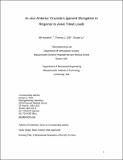In-vivo Anterior Cruciate Ligament Elongation in Response to Axial Tibial Loads
Author(s)
Hosseini, Ali; Gill, Thomas J.; Li, Guoan
DownloadHosseini_In-vivo Anterior.pdf (2.830Mb)
PUBLISHER_POLICY
Publisher Policy
Article is made available in accordance with the publisher's policy and may be subject to US copyright law. Please refer to the publisher's site for terms of use.
Terms of use
Metadata
Show full item recordAbstract
Background: The knowledge of in vivo anterior cruciate ligament (ACL) deformation is fundamental for understanding ACL injury mechanisms and for improving surgical reconstruction of the injured ACL. This study investigated the relative elongation of the ACL when the knee is subject to no load (<10 N) and then to full body weight (axial tibial load) at various flexion angles using a combined dual fluoroscopic and magnetic resonance imaging (MRI) technique.
Methods: Nine healthy subjects were scanned with MRI and imaged when one knee was subject to no load and then to full body weight using a dual fluoroscopic system (0°–45° flexion angles). The ACL was analyzed using three models: a single central bundle; an anteromedial and posterolateral (double functional) bundle; and multiple (eight) surface fiber bundles.
Results: The anteromedial bundle had a peak relative elongation of 4.4% ± 3.4% at 30° and that of the posterolateral bundle was 5.9% ± 3.4% at 15°. The ACL surface fiber bundles at the posterior portion of the ACL were shorter in length than those at the anterior portion. However, the peak relative elongation of one posterolateral fiber bundle reached more than 13% whereas one anteromedial fiber bundle reached a peak relative elongation of only about 3% at 30° of flexion by increasing the axial tibial load from no load to full body weight.
Conclusions: The data quantitatively demonstrated that under external loading the ACL experiences nonhomogeneous elongation, with the posterior fiber bundles stretching more than the anterior fiber bundles.
Date issued
2009-06Department
Massachusetts Institute of Technology. Department of Mechanical EngineeringJournal
Journal of Orthopaedic Science
Publisher
Springer Japan
Citation
Hosseini A, Gill T, Li G. In vivo anterior cruciate ligament elongation in response to axial tibial loads. Journal of Orthopaedic Science. 2009;14(3):298-306.
Version: Author's final manuscript
ISSN
1436-2023
0949-2658